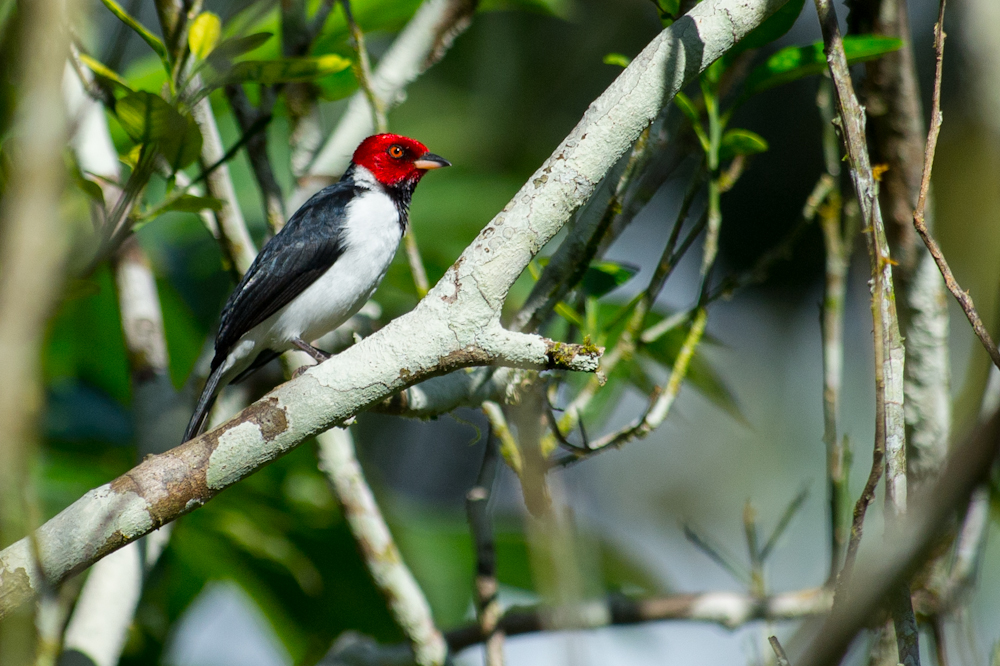Red-capped Cardinal is the most widely distributed of the genus Paroaria, being widespread in the tropical lowlands east of the Andes. Due to the general lack of geographical overlap with congeners, this is a distinctive species. The head and chin of the Red Capped Cardinal are crimson-colored, with glossy blue black upperparts, a black bib, white underparts, and a largely black bill. This songbird species can be found throughout north and central South America.

Image source: Joao Quental [CC BY 2.0 (https://creativecommons.org/licenses/by/2.0)]
Scientific Classification
The Red-capped Cardinal is a medium-sized passerine belonging to the family Thraupidae, commonly known as the tanagers. The genus name “Paroaria” is derived from the Tupí name Tiéguacú paroára referring to a small bird with yellow, red and grey plumage. The species name “gularis” comes from the Latin word “gula” meaning throat. Paroaria gularis is the scientific name of the Red capped Cardinal.
Features
- The Red-capped Cardinal has a slender body, black on top and white below. The head of the Red-capped Cardinal is red with a flat crown, a red chin, and a black bib. It has a blackish lores and ocular region. The shiny black upperparts, has a white partial collar extending up the neck sides from the white underparts. The throat is black, extending to a point on the upper chest. The upper mandible is black, while the lower is pale flesh-coloured. The legs are dark grey (almost black) and the irisis brownish-orange. In pattern the juvenile resemble the adults, but the upperparts are dusky-brown, the head is deep brownish-buff (darker on the cap), the bill is entirely black and the iris is pale, dull creamy-yellow.
- The Red-capped Cardinal is said to be generally a quiet bird. Their song is a clear, sweet “suweet-chú” that rises and falls in repeated, short intervals. The Red-capped Cardinal also sings a dawn song, which is a repeating note described as a “weé-tju” . Their call is characterized as a “chap” or “chelep”. In addition to that, this species sometimes mimics.
- These birds have a length of approximately 16.5 cm(6.5 in.) and a mass of approximately 31g
Diet
The Red-capped Cardinal feeds primarily on seeds, berries, rice and insects found in its wetland habitat. The presence of highly developed muscle in the gizzard of the Red-capped Cardinal confirms morphology to be in accordance with their diet.
Reproduction
The nest of the Red Capped Cardinal is built from dry grasses and twigs. It is placed in a branch of an isolated bush or small tree overhanging water and made into a cup shape. However, there is often a threat of nest destruction in Amazonian watersheds if water levels rise drastically. Eggs are nested approximately 30cm above water which measures about 21.6 ± 0.5 mm by 16.0 ± 0.1 mm. A clutch is commonly 2 eggs. Eggs are off-white with spots of sepia and dark brown and are usually covered. Moreover, there is a threat of brood parasitism by the Argentine Shiny Cowbird, Molothrus bonariensis bonariensis. Three sets of Red-capped Cardinal eggs have been identified with evidence of brood parasitism by the Argentine Shiny Cowbird in Brazil during November of 1926. These nests each contained one Argentine Shin Cowbird egg and one to three Red-capped Cardinal egg.
Habitat
Red capped Cardinal is a mall, boldly colored tanager found in vegetation around lakes and rivers. Bright red head and black-and-white plumage are instantly recognizable. Quite social and often found in pairs or groups as they forage low in waterside vegetation. Frequently perches on branches sticking out of the water. This is a bird of swamps, mangrove and other semi-open areas near water. It is generally common, and even occurs in lightly wooded wet habitats in towns or cities
Territoriality
The permanent territories within which pairs of Red-capped Cardinal inhabit and forage are defended by themselves. Whether singles or pairs, territorial Red-capped Cardinal are known to conduct their activities in locations that have high visibility of their territory. These activities include not only sitting and preening, but also foraging. However, this behavior is not observed in non-territorial Red-capped Cardinal. Within the Amazon Basin, rather than defending one long piece of the shoreline, Red-capped Cardinal generally defend two shorter pieces of opposite shores. Individuals without territories intrude either alone or in groups on other territories, or join a flock. A flock, normally consisting of 20-40 individuals, usually moves throughout multiple territories. When intruders are detected, more specifically lone intruders, territory owners evict either through physical or non-physical acts. Evictions are often highly visible events because territory owners will call, chase intruders, or provide escort flights to the territory’s boundaries.
In pairs or groups, non-territorial Red-capped Cardinal will often enter a territory together, stay within 3 m of one another, and generally leave together.
Article References
- https://ebird.org/species/reccar4
- https://neotropical.birds.cornell.edu/Species-Account/nb/species/reccar4/breeding
- https://en.wikipedia.org/wiki/Red-capped_cardinal#Distribution_and_habitat
- https://www.lpzoo.org/animal/red-capped-cardinal







